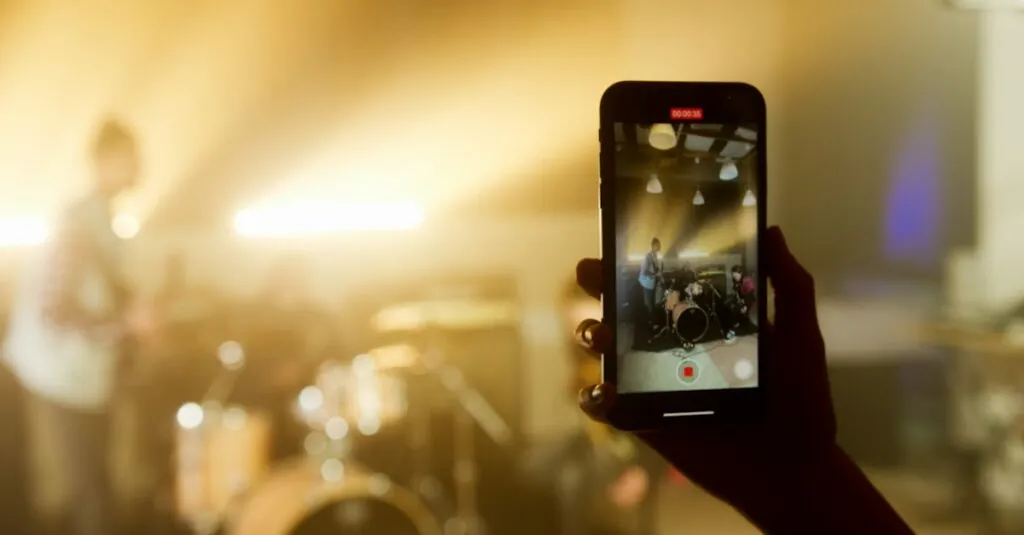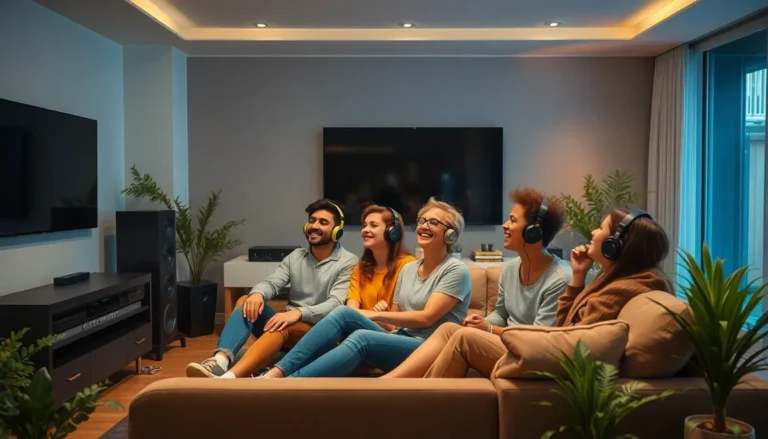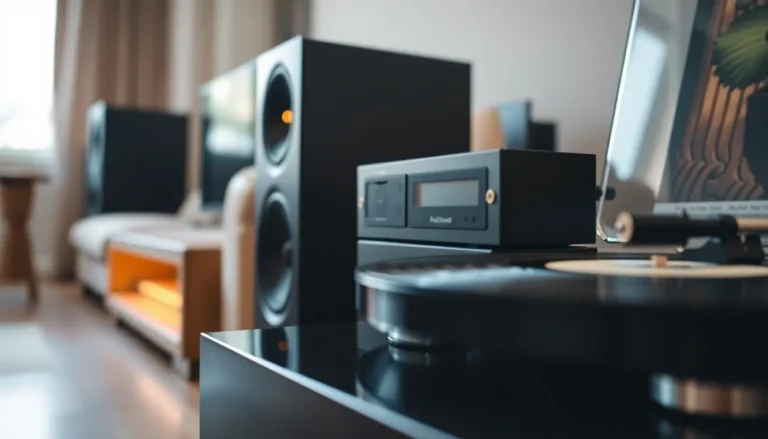In a world where the arts collide with cutting-edge technology, creativity knows no bounds. Imagine a place where vibrant visuals dance across screens and soundscapes transport audiences to new realms. That’s the magic of arts, audio/video technology, and communications. It’s not just about the tools; it’s about the stories they tell and the emotions they evoke.
Table of Contents
ToggleOverview of Arts, Audio/Video Technology and Communications
Arts and audio/video technology play a critical role in modern communications. This integration fosters innovative approaches, allowing creators to share stories effectively. Visual art combined with digital media generates unique experiences that captivate audiences.
Audio technology enhances presentations through immersive sound, drawing listeners into narratives. Video elements create dynamic storytelling, displaying images that evoke powerful emotions. Live performances leverage advanced setups to engage viewers through interactive elements, bridging the gap between artist and audience.
Emerging technologies impact the arts by introducing new tools and methods. Virtual reality (VR) immerses audiences in digital landscapes, expanding the boundaries of artistic expression. Augmented reality (AR) enhances physical artworks by integrating digital components, making interactions more engaging.
Furthermore, social media platforms amplify the reach of art and communication. Artists showcase their work to diverse audiences, fostering global connections. Interactive content facilitates direct engagement, allowing for real-time feedback and collaboration.
This intersection of arts and technology supports the growth of creative communities. Networking opportunities arise as creators connect across various platforms, sharing knowledge and inspiration. Collaborative projects often yield innovative results, reflecting the diverse influences within the contemporary landscape.
Ultimately, arts, audio/video technology, and communications intertwine seamlessly, redefining how stories are told and experienced. The evolution of this field continues to inspire new possibilities, highlighting the importance of creativity in shaping modern culture.
Impact of Technology on the Arts
Technology significantly influences the arts, reshaping how creators express themselves and connect with audiences.
Digital Art Platforms
Digital art platforms revolutionize the art creation process by providing accessible tools for artists. Numerous websites and applications allow artists to share work easily, reaching wider audiences. Artists benefit from features like online galleries and social networking integration, enhancing visibility. Collaborative projects thrive on these platforms, encouraging innovative exchanges among creators. Emerging tools often incorporate AI to assist in design, pushing boundaries in artistic exploration.
Streaming and Distribution Methods
Streaming services play a critical role in how audiences consume art today. Artists can distribute their work globally and quickly through platforms like YouTube and Vimeo, bypassing traditional barriers. Audiences find diverse content that extends beyond conventional forms, including live performances and interactive installations. Moreover, subscription models facilitate ongoing access to creative content, fostering loyalty among viewers. Strategies for direct engagement through streaming encourage immediate audience feedback, enhancing the creative process.
Audio/Video Innovations
Audio and video technologies continue to evolve dramatically, reshaping the creative landscape. Innovations in these fields enhance artistic expressions, engaging audiences with immersive experiences that captivate.
Sound Design and Engineering
Sound design plays a pivotal role in audio innovation. Professionals utilize advanced software to create soundscapes that elevate narratives and emotions. Innovative sound engineering techniques enhance clarity, depth, and ambiance, providing richer experiences. By applying immersive audio technologies, creators can transport audiences into new worlds. Tools like spatial audio and surround sound systems amplify the listening experience, making it more interactive. These innovations not only increase audience immersion but also expand creative possibilities for artists.
Visual Effects and Animation
Visual effects and animation have transformed storytelling in film and digital media. Artists employ cutting-edge software to create stunning visuals that bring imagination to life. Using 3D modeling and animation techniques, they craft breathtaking scenes that enhance the narrative. Interactive animations engage viewers, allowing them to explore different perspectives. Recent advancements in rendering technologies streamline workflows and improve visual quality. By integrating these elements, creators can merge traditional art with modern techniques, making compelling content that resonates with diverse audiences.
Communication in the Arts
Communication in the arts relies heavily on the synergy between technology and interaction. This evolution leads to innovative ways for artists to connect with their audience.
Role of Social Media
Social media platforms play a vital role in promoting art and engaging with audiences. Artists utilize Instagram, Facebook, and TikTok to showcase their work visually, reaching global audiences. They share behind-the-scenes content, revealing their creative processes and building a personal connection with followers. Engagement through comments and shares fosters immediate feedback, allowing artists to adapt their approaches based on audience preferences. Hashtags and online challenges also encourage community participation, making art more accessible and interactive. This shift not only enhances visibility but also cultivates a supportive network for collaboration among creatives.
Audience Engagement Strategies
Artists implement various audience engagement strategies to enhance viewer experiences. Interactive installations encourage participation, blurring the lines between creator and audience. Live streaming of performances allows real-time interaction, enabling viewers to influence the event with comments and suggestions. Using polls and quizzes during virtual exhibitions sparks discussions, creating a more dynamic and engaging environment. Additionally, incorporating augmented reality features can transform static artworks into immersive experiences. Offering online workshops and tutorials enables audiences to develop skills, deepening their connection to the art form. These strategies underscore the importance of maintaining a two-way dialogue between artists and their audience.
Future Trends in Arts, Audio/Video Technology and Communications
Technological advancements shape the future of arts and communication in profound ways. Virtual reality (VR) offers immersive experiences that transport audiences into new realms of artistic expression. Augmented reality (AR) enhances physical artworks, integrating digital components that deepen viewer interaction. These innovations provide creators with tools for expanding their narratives beyond traditional formats.
Streaming services continue to transform content consumption. Artists utilize platforms like YouTube and Vimeo to share their work globally. This instant access promotes diverse artistic offerings, including live performances. Innovations in subscription models contribute to viewer loyalty through ongoing engagement.
Collaboration tools redefine the creative process, bringing artists together across geographical boundaries. Online galleries and social media enhance visibility, allowing for real-time feedback and support from global audiences. Artists adapt their approaches based on instantaneous reactions, fostering a dynamic creative environment.
Sound design remains crucial for storytelling. Enhanced audio technologies elevate narratives, creating immersive soundscapes that captivate audiences. Visual effects and animation play significant roles too, enabling artists to produce stunning visuals that complement their stories. Advanced software allows for complex, layered storytelling that resonates with viewers.
Interactive installations gain traction as a method for audience engagement. These experiences foster two-way dialogue between artists and their audiences, encouraging community participation. Live streaming performances allow audiences to connect in real-time, blurring the lines between creator and consumer.
Social media platforms become essential tools for artistic promotion, offering unique opportunities for artists to share their creative journeys. Engaging content behind the scenes builds personal connections, increasing follower loyalty. Overall, these trends underscore an evolving landscape that prioritizes collaboration and innovative storytelling approaches.
The fusion of arts and audio/video technology is driving a new era of creativity and communication. As artists leverage innovative tools and platforms they’re not just enhancing their work but also transforming how audiences engage with it. The rise of immersive experiences through VR and AR showcases the limitless potential for storytelling in the digital age.
Streaming services and social media have democratized access to art enabling creators to reach global audiences instantly. This shift encourages collaboration and real-time feedback fostering a vibrant artistic community. The ongoing evolution of sound design and visual effects continues to elevate narratives making them more compelling and relatable.
Ultimately this dynamic interplay of technology and creativity is reshaping modern culture inspiring future generations of artists and audiences alike.





